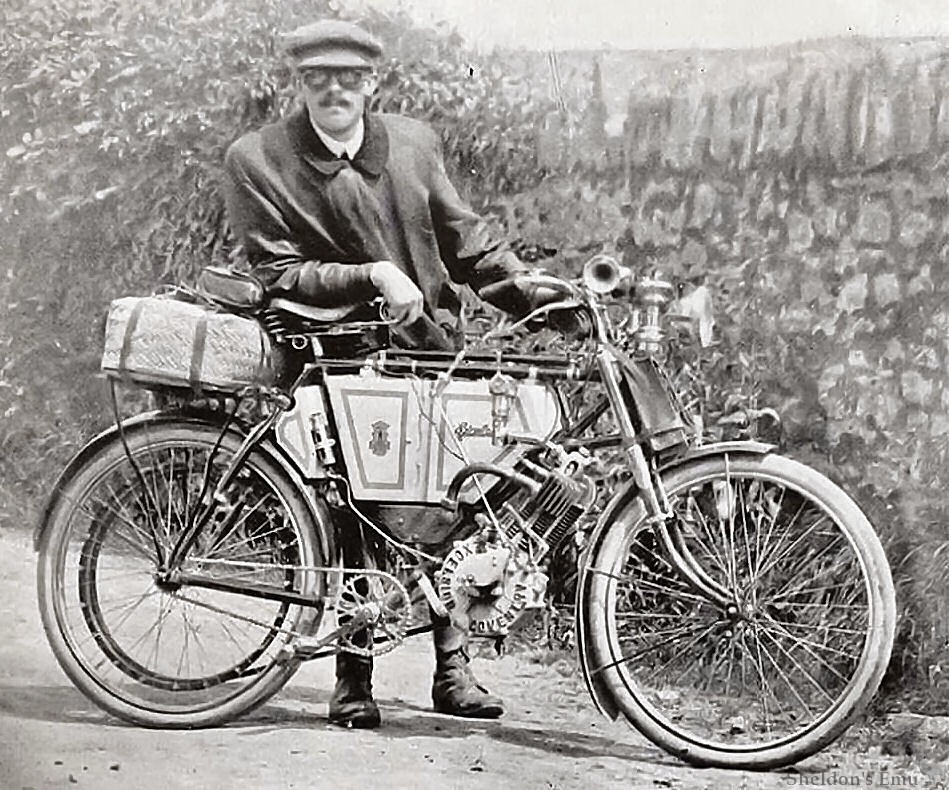


The Excelsior machine with M.M.C. engine temporarily saved the juvenile motorcycle industry from extinction. It scaled about 220 lbs., could easily romp up hills like Dashwood at high speed, and was capable of 45 miles an hour on the level. Of course, it was topheavy and prone to sideslip. Its V-shaped belt gave continual trouble in dusty or wet weather. Its ignition was disfigured by the usual unreliable contact-breaker and accumulator. Nevertheless mine carried me some 15,000 miles without undue delay and without a single recourse to the railway. Its debut was not encouraging. I was then at the impressionable age, and it seemed desirable to furnish accommodation for an occasional flapper. The makers rashly guaranteed that their 2-3/4 h.p. engine - a giant for those days and bigger than some modern 3-1/2 h.p.'s - would carry two people anywhere.
The sidecar had not then been invented and the trailer was our custom. Now a trailer at the best does not lend itself to ardent affection in travel. Most of us used pushbike trailers, and their connections used to break. In dry weather we glanced astern every half mile or so to see that all was well. On greasy roads we dare not take our eyes off the going, and periodic shouts of "Are you there, darling ?" were the rule. One day I gave the code call, and there was no voice nor any that answered.
The trailer bar had snapped, and Arabella had turned a neat back somersault, chair and all, landing heavily on her bustle against the hard high road. This incident led to ultimatums. I must either give up the motor, or give up Arabella. She would never again occupy a trailer. Neither would she trust me or spare me to career about the countryside alone; blue-eyed Devonshire maidens with creamy complexions were too numerous and too charming. I weighed my - demarche, don't the diplomatists call it? At this stage the Excelsior traveller came down to our burg. I confided in him piteously. With a flourish he produced a folder illustrating "Our new forecar." I denuded the bank coffers, and ordered one.
Presently the outfit arrived. The motor bicycle had been converted into a tricarriage by removing the front wheel, and attaching a two-wheeled axle with a basket chair slung upon it. The steering was coupled up to the bicycle front forks, and the front chassis was fixed to the front down tube of the cycle frame by a single clip resembling a human fist executed in metal. I tested the beast for the first time with the chair empty. It created a huge sensation on our boulevards, and I felt convinced that Arabella would surrender to it at sight; moreover there was every hope that I could occasionally lean forward and kiss her ear, at least on good roads. Steering it onehanded and sucking a big cigar I abandoned myself and my new purchase to the unstinted admiration of the populace.
Alas! That infernal clip slipped round the down tube of the cycle frame. The forecar did a half-left turn, the cycle frame remaining as you were, and the outfit capsized noisily against some iron railings at the foot of the hill. Arabella did not witness this catastrophe, but she heard of it, and we parted. I replaced the bicycle wheel, and rode solus for weeks.
As the times went, that machine served me nobly. I substituted a metallic wipe contact and a trembler coil for the original ignition, and so long as I kept the accumulator up to snuff, the belt remained the sole anxiety. She accomplished such formidable trips as the entire circuit of the county of Devon in a day; and on a blazing June day she travelled from Cornwall to London.
From Reminiscences of Motor Cycling, by Ixion (Canon Basil Davies, BA), 1920
Further reading: https://stwenn.co.uk/2022/06/03/the-reverend-basil-henry-davies/